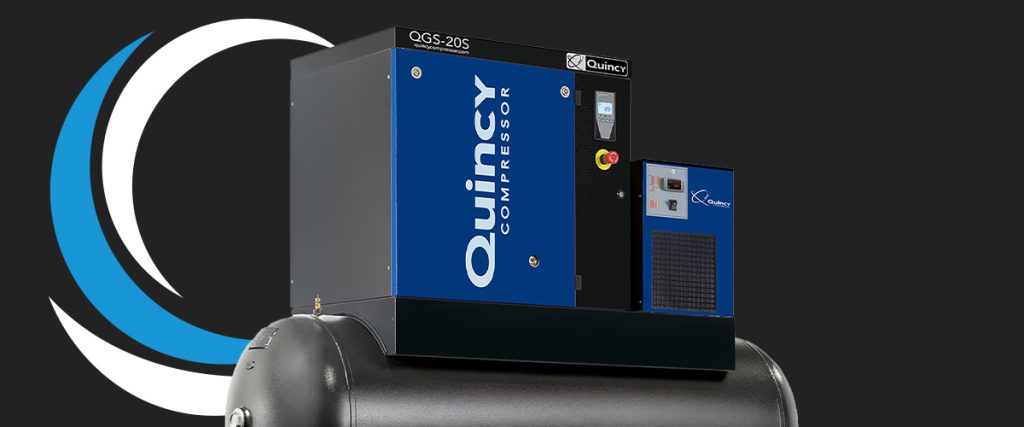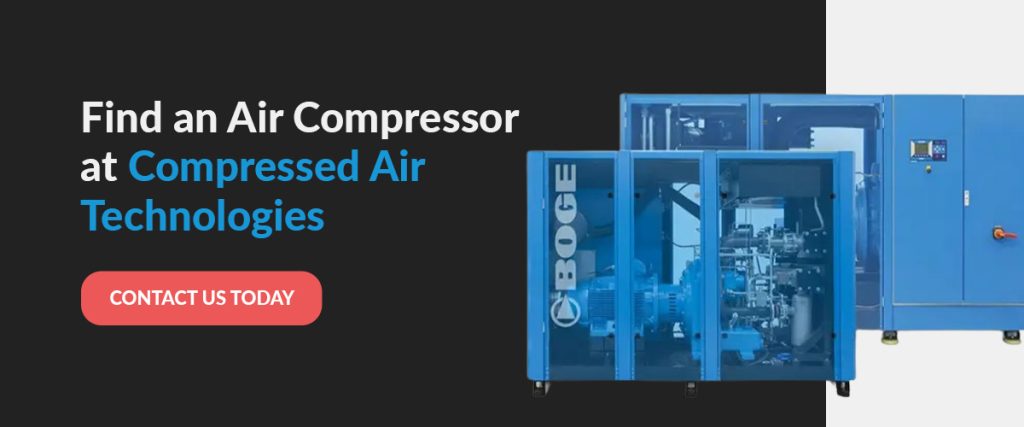

Air compressors are essential tools in many industries, and choosing the right type can make all the difference in terms of efficiency, cost and performance. Reciprocating and rotary screw compressors are the most common types, each with unique characteristics.
Understanding the differences can help you make an informed decision and get the most out of your investment. Read on as we take a closer look at rotary versus reciprocating compressors, compare their features and benefits, and help you determine which one best fits your needs.
Reciprocating air compressors use pistons and cylinders to compress air. They work by drawing air in through an intake valve and compressing it with a piston that moves back and forth inside a cylinder. The compressed air resides in a storage tank until the user needs it.
Reciprocating air compressors, also called piston compressors, can be either single-stage or two-stage, with the two-stage being more efficient and capable of producing higher pressures. Reciprocating air compressors are typically used in smaller applications, such as powering pneumatic tools or inflating tires, but they can also work in larger, industrial settings.
The advantages of reciprocating air compressors include that they’re relatively simple in design, easy to maintain and made with many readily available parts. They’re also more affordable than other air compressors, making them a popular choice for businesses on a budget. However, while maintenance is easy, maintenance is also frequent. Reciprocating air compressors can also be noisy and less energy-efficient than other types.
Overall, a reciprocating air compressor is a reliable and versatile tool for many applications, especially those requiring intermittent use of lower volumes and pressures of compressed air.

Rotary screw compressors use two interlocking helical screws, known as rotors, to compress air. A rotary screw compressor works by drawing air in through an inlet valve and compressing it between the two screws as they rotate. The turning rotors continuously create compressed air, which resides in a receiver tank until users need it. The screws are designed to interlock to make a continuous seal, which helps prevent air from leaking out during compression.
Rotary screw air compressors can be either oil-injected or oil-free, with oil-injected compressors being more efficient and capable of producing higher pressures. Rotary screw compressors are typically used for larger applications, such as powering heavy machinery or providing compressed air for industrial processes.
One of the advantages of rotary screw compressors versus reciprocating is that they’re more energy-efficient, requiring less energy to produce the same amount of compressed air. They’re also quieter and require less maintenance than reciprocating compressors, making them a popular choice for many industrial settings. However, rotary screw compressors are typically more expensive than reciprocating compressors.
Overall, rotary screw air compressors are powerful, efficient tools great for those who need high volumes and pressures of compressed air.
Reciprocating and rotary screw air compressors differ in many key ways. Consider some of their differences below.
Reciprocating air compressors use crankshaft-driven pistons, while rotary screw air compressors use two interlocking helical screws to produce air.
Rotary screw compressors are generally more efficient than reciprocating compressors. Rotary screw compressors can produce more air than reciprocating compressors of the same size and require less energy to produce the same amount of air. Additionally, reciprocating compressors require air reservoir tanks to handle more considerable air demands and reduce air pulses created in the compression process, which can reduce their efficiency.
Rotary screw compressors are generally quieter than reciprocating compressors. However, noise levels can vary depending on the specific make and model of the compressor and the environment in which it’s used. Factors like the room acoustics, piping type and sound-dampening materials can all affect an air compressor’s noise level.
Rotary screw air compressors generally require less maintenance than reciprocating air compressors because rotary screw compressors have fewer moving parts than reciprocating compressors. This reduces the need for frequent maintenance.
Rotary screw compressors usually require simple filter and lubricant upkeep, while reciprocating compressors have multiple parts that need frequent checks, such as valves and piston rings.
Rotary screw compressors generally deliver more airflow than reciprocating air compressors of the same size. This is because rotary screw compressors use rotors to compress air, while reciprocating compressors use pistons powered by a crankshaft. Rotary compressors’ design allows for more continuous airflow, making them better suited for applications with higher compressed air demands.
Rotary screw compressors continuously produce air at pressures up to 210 pounds per square inch (PSI). Reciprocating air compressors can create higher compressed air pressures, reaching up to 600 PSI or more. However, the moving pistons in a reciprocating air compressor can generate varying pressures, resulting in air pressure pulsations and fluctuations.
Rotary screw compressors are bigger and heavier than reciprocating compressors. Because they deal with larger air volumes, they have large motors that require more space or even an additional room. Alternatively, reciprocating air compressors are small and compact, allowing for easy installation in tight spaces.
The right air compressor depends on your application. Reciprocating air compressors are useful in various applications across different industries, including manufacturing, transportation, construction and maintenance. Reciprocating air compressors are great for the following uses:
Rotary screw air compressors also have many applications across various industries. They’re commonly used in manufacturing, automotive, construction and agriculture industries. Specific rotary screw compressor applications include the following:

We hope this comparison of rotary screw compressors versus piston air compressors has helped you become familiar with two of the most common air compressors on the market. When you’re ready to invest in an air compressor for your business, come to Compressed Air Technologies, where you’ll find complete lines of compressors, air treatment products and specially engineered air solutions, plus an authorized repair and service center. Contact us today to learn more — our highly trained staff look forward to helping you!